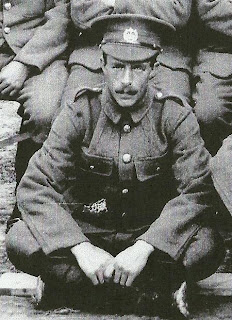George Albert Greeno was born in 1889 in Bethnal Green and attended Hague Street Primary School which is now the Weavers Fields Nursery.
Canrobert Street in Bethnal Green
He married Alice in 1908 and lived with his wife and two daughters down Vallance Road but by the time he volunteered in the West Ham Battalion he was living at 94 Canrobert Street in Bethnal Green and employed as a sail maker.
George in a group photo of C Company
George was a member of C company and was used as a Battalion Runner, one of several extra dangerous roles on the front-line.
George's Will made out to Alice in his paybook
During the Hammers first trench raid on June 1st 1916 it was George who had to creep out with the raiders to their attack positions and then return with absolute stealth back to the British line and inform the Brigade artillery that everyone was in their place. For this role in the attack, during which the battalion were awarded three Military Cross's (MC), a Distinguished Conduct Medal (DCM) and several Military Medals (MM), George was rewarded with a Commander's Commendation
George's trench raid Commendation
A year after the trench raid, George was utilised as an Officer's Batman, a personal 'servant' in the dugouts. It was in the dugouts around Windy Corner that George was somehow "accidently wounded by a revolver shot"... Frank Jenns (who was writing up the War Diary) gives no indication as to who shot him in the thigh, but the fact that Jenns doesn’t say "by comrade" might imply that the fault lay with an Officer, receiving an unlucky reminder that the Webley pistol issued at this time had no safety catch!
George's paybook also contains the signatures of many Officer's
in the West Ham Battalion,most of whom were Killed In Action
George recovered from his wounded thigh and returned to the West Ham Battalion. On disbandment he was sent to Egypt and thankfully survived the Great War.
All for a shilling a day!
Sadly he had to return his medals as they were engraved with the wrong name "Greens"! George died in 1951.
with thanks to the Greeno family for images











